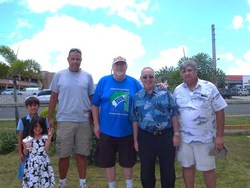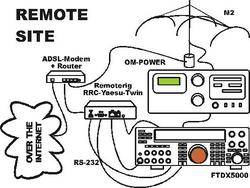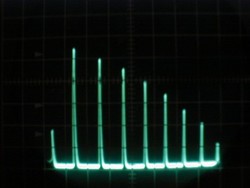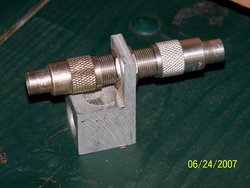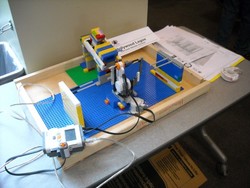 April 11, 2012 Editor: Ward Silver, NØAX | |||||||
IN THIS ISSUE
NEW HF OPERATORS - THINGS TO DO Definitely make a hole in your schedule to give the ARRL Rookie Roundup's SSB edition a try - it's a contest specifically for new hams. If you want to give DXing a try, tune for the Japan International DX or YU DX Contest and listen for these stations calling CQ. BULLETINS The ARRL Frequency Measuring Test (next Thursday evening in North America, April 19th) will use an 80 meter frequency near 3575 kHz (not 3569 kHz as in the text of the QST article - the schedule table is correct). The ending announcement of the 40 meter segment will include the approximate frequency on 80 meters. The MT QSO Party is on Apr 14/15, not Apr 7/8, and has shortened the log deadline significantly to 7 days. BUSTED QSOS The NEQP was the first of the large regional QSO parties to sustain a presence on the bands, first running in 2002, followed by the 7QP in 2006. (Thanks, Tom K1KI) John KS6M reminds your editor that it was the Ditto machine - not a mimeograph - that required the use of solvent to transfer the usually-purple wax to our tests and handouts. Relive those days of yesteryear via the Wikipedia entry on spirit duplicators. And of course, in the table of SS results, there were five entries, not three. Three remains not equal to five, even for very large values of three. CONTEST SUMMARY Complete information for all contests follows the Conversation section April 14-15
April 21-22
Congratulations to Jim Reisert AD1C on his election to the CQ Contest Hall of Fame! Jim was nominated by the Southeastern DX Club for this most prestigious honor. Jim is best known for his long and careful maintenance of the CTY files used by nearly every contest logging program. Jim will be inducted at the Dayton Contest Dinner during the Hamvention. (Thanks, Bill N4NX) The ARRL Rookie Roundup takes to the airwaves on April 15th - with this running come the new categories of multioperator entries and Rookie team competition. Implemented after requests from all of you out there in radiosport land, both are great ways to get new operators on HF, especially clubs. The April edition of Rookie Roundup takes place using SSB (Aug is RTTY and Dec is CW) so limber up those PTT switches. You can use a standalone logging program (N1MM supports RR, for example) or use the new In The Log online logger.
All of those big QSO parties (NEQP, 7QP, INQP) on the first weekend of May can accept combined logs and will sift out "their" QSOs for you. N1MM software can handle the multiple QSO parties by choosing QSOPARTY under Log Type, then pick the IN7QPNE under "State for log type". CQ/X also supports several other combinations of QSO parties and will split the log into individual contest submissions. (Thanks, Tom K1KI, Dick K7XU, Steve N2IC, and Chuck NO5W) WRTC 2014, Inc., host of the 2014 World Radiosport Team Championship competition, is pleased to announce that the tribander antennas to be used for the competition will be the Cycle 24 Antenna Products Company TX38. The antenna has 8 full-sized elements (2 elements each on 20 and 15 meters and 4 elements on 10 meters) on a 14.5 foot (4.4 meter) boom and weighs only 30 pounds. It will be commercially available in July. (Thanks, WRTC 2014 Co-chair, Randy K5ZD) The revised rules for the 2012 IOTA Contest now appear on the RSGB Contest Committee website. The World Multi-Operator category has been discontinued, Island Multi-Operator stations must observe a "6 band mode/band changes per hour" rule and must identify Run and Multiplier stations in their log. The score for non-island to non-island QSOs is reduced from 3 points to 2 points and Low Power island expedition stations can now choose any antenna that they want. (Thanks, IOTA Contest Manager, Don G3XTT) A video presentation on digital-mode contesting by ARRL Publications Manager, Steve WB8IMY was recorded and has been posted to the Potomac Valley Radio Club's website. It is accessible via the Recorded Webinars link. (Thanks, PVRC President, Ken K4ZW) A recent EE Times "Ham Radio Today" column details one route into the engineering field - ham radio - as taken by Jack N3ALO who also writes the "Break Points" column for Embedded System Design. (Thanks, Dave KU4B) Here are some guidelines for RTTY contesting by Ed WØYK. They are aimed at CW/SSB contesters to help them learn the "ways and means" of digital contests. 1. Although strange to CW/SSB Sprinters, it is common practice in all RTTY contesting to end CQ messages with 'CQ', and only 'CQ' after your call sign(s). 2. Just send your call sign once or twice depending on the specific situation. No need to send it twice if once will get through. You just need to balance brevity (speed) vs. reliable communication. 3. Generally send unique exchange elements twice. This definitely applies to the serial number in RTTY contests but use judgment for the NAME and QTH. RTTY serial numbers really do need to be sent twice because a small noise spike could transform one number and you'd never know it by ear like you do on CW and SSB. Web Site of the Week - Here's another interactive map - this one shows "live" wind predictions across the US. Click on the map to zoom in and click the "Unzoom" button at left to restore the original view. This map does put a load on the web browser software so it might bog down with an older PC. (Thanks, Bob N6TV) WORD TO THE WISE Self-spotting - the practice of posting your own call sign and frequency on the spotting networks (or asking someone else to do it for you) is specifically not allowed in nearly all contests - even for Assisted, Unlimited, and multi-operator entries. Why? Because it's a form of CQing that takes place outside the amateur bands. This includes websites like Facebook, Twitter feeds, chat rooms, instant messaging and other Internet gadgets. Don't do it! Rem K6BBQ produced a YouTube video of his recumbent bicycle mobile QRP operation in last year's Salmon Run, a.k.a. the Washington State QSO Party. He logged some miles alongside San Francisco Bay, ate carnitas, and contacted several stations in Washington - all on the go!
The K5QE team has been making a lot of noise and working hard in recent VHF+ contests. Here's a video all about this big and growing station. (Thanks, Dick N6AA) If you're getting ready for the Dayton Hamvention in May here's a video about the early years of this super-sized ham radio convention and hamfest. (Thanks, Tim K3LR) April 1st isn't so far gone that a chuckle's not still in order. Take a look at this Wouff Hong garden. Got several thousand diskettes full of logs and don't have time to transfer them? Try this handy diskette reading robot! (Thanks, Sean KX9X) The world has returned to normal with the publication of the Poisson d'Avril Contest results. I believe sponsor, log checker, and prize manager Doug K1DG is already hard at work on next year's results, too! Results from the 2011 New England QSO Party have been posted. Certificates will be mailed out during the next week and plaques shortly afterwards. (Thanks, Tom K1KI) The CWJF Group has released results of the 2011 CQMM DX Contest. (Thanks, Luc PY8AZT) The results of the 2011 JIDX CW contest have been posted. The JIDX committee is processing the 2011 SSB logs and expects to have them online before long. (Thanks, Tack JE1CKA) Online databases of contest results are yours for the browsing. Steve N2IC recommends Pileup and Bob N6TV the DXwatch 3830 report finder. OPERATING TIP How do you hear through static crashes? The Topband reflector tackled that topic in March and you can follow the discussion via the online archives. Search for "static" in the thread view and you'll find the messages.
Radio Arcala team member Toni OH2UA was at the controls of CQ8X for a serious contest operation in the Azores for WPX SSB. That's not unusual. What was unusual is that the 4543 contacts were made over a remote link across the Internet - 4500 kilometers from the actual station! Remote operation is becoming more and more common. Big scores like CQ8X's 15 million points show that remoting can work well! Magazine Roundup
The Instructables website features a nice application of 3D printing with a combination printed-circuit board holder and parts drawer. If you have access to one of these handy devices - I think I need one! - you can soon have yourself a new workbench gadget. Ken WØLSD offers an inexpensive method of improving your rotator's grip on the antenna mast. "Go to your local tire shop and get an old inner tube. Cut a piece that will fit in the area between the rotor clamp and the mast. When you tighten the clamps it is almost impossible for the mast to turn. It also seems to act as somewhat of a cushion for vibration and I have not had nuts loosen on the U bolts." Dan N5AR observes that baler belting is another similar material and widely available in hay country. Pat AA6EG discovered a source of HV air-dielectric capacitors. His local Goodwill store has large numbers of air cleaners, each of which includes a low-current HV supply, for a few dollars. The capacitor consists of a stack of well-insulated interlaced metal plates with 1/8 to ¼-inch spacing through which the fan pulls incoming air to trap the dust. To minimize noise conducted from a tower attached to a building, John NA6L recommends some form of sound insulation between the tower and the house brackets or between the brackets and the structure. He added some 1/4" thick by 2" wide strips of neoprene between the tower legs and the house bracket and that got rid of about 70% of the noise. Perhaps this is another use of that baler belt mentioned previously!
Jim VE7RF points out that a safety choke at the output of an amplifier's pi network may not work when the amplifier is in receive mode. To function in both receive and transmit, the choke should be connected directly to the center conductor of output coax connector. This point is in-circuit at all times. A cheap heat gun (~$20) can make quick work of desoldering a PCB, says MAKE author Steve Hobley. Place the PCB upside down over a bucket, heat the board with a stream of hot air, and listen to the parts drop off. Tim K3LR reports clearing an audio distortion problem on an IC-7700 by resetting the radio's firmware. Some configuration setting had been changed - no one remembers which or why - causing problems with the output audio. Now added to the Pre-Contest K3LR Checklist - resetting all of the radio firmware to the factory defaults so that changes made (and forgotten) in the heat of the contest are not carried forward unwittingly to cause problems in the next contest. That returns all filters back to "normal", clears VFO settings, all examples of the innumerable small details that you never think of when sitting down to the radio with the pre-contest adrenaline pumping.
Technical Web Site of the Week - After the story about the Q-Up Now NVIS propagation prediction tool in ARRL Propagation Bulletin ARLP014, Marv N5AW also recommended the GRAFEX prediction tool from IPS to get a prediction for conditions over any path, over the current day. (Not all browsers will recognize the applet and may require an upgrade of the Java package.) Just click on any two points of interest on the map, watch the green arc indicating the path, then click on the "Do Prediction" button. The result is a very basic rendering using plain ASCII characters. The OWF figure represents "Optimum Working Frequency." (Thanks, Tad K7RA) On Your Marks! There is nothing better than a good sprint contest...except maybe a good ramble through a large hardware emporium on a construction safari, designing as you go. Inspired by the adaptation of a breaker-box ground lug above, I thought, "Why not combine the two? We've all seen the videos of "Junkyard Wars" - how about "Hardware Wars"? Around the ARRL Lab, Zack W1VT is well-known for his "Le Mans Start" to Field Day - beginning with a pile of parts and assembling a QRP rig beginning at 1800Z on Saturday. And you thought putting up the antennas was hard!
So here's the idea and let's run with it, so to speak. On the appointed day, contestants, spectators, and judges gather in the parking lot of your favorite hardware emporium. (It might be a good idea to let the management know what you're up to...) The requirements are kept secret in sealed envelopes until the teams are allowed to open them. Only then do they learn what it is that they must build - antenna, transmitter, tuner, or ??? And they're off! Baskets and carts in hand, they scour the shelves looking for adaptable and re-purpose-able parts that can be cobbled together into something approximately the desired result. Are they going to find proper electronic parts? Not likely! And that's most of the fun - seeing how creative minds can see the potential in a pile of plumbing parts. Assembly - maybe that has to take place in the parking lot, too...with a strictly limited number of re-entries for additional material. Bring your own tools and work out of the back of the truck - just like real field engineers do! Each project should entail a mix of soldering, cutting, sawing, gluing, and all those things that make homebrewing so much fun. Points for presentation? Oh, most definitely! The pattern of ventilation holes that make a happy face or bending the supports struts into the classic radio rhombic - extra points for sure! It does still have to actually, you know, work - but what would a classic Stratocaster be without its whammy bar and the 1959 Cadillac without its tail fins? Devices that collapse, fly apart, melt, or let out the magic smoke - well, that's all part of the game and should be applauded for audacity. Just think of it as the homebrewing equivalent of skittles chess - no time for too much of the furrowed brow. Haul out the pliers and get 'er done! Of course, what competition is complete without a post-finish trip to a local eatery or park for celebratory consumption? Awards, prizes, photos - all served up with a smile. It might be one of the best contests your club ever had and it's all within reach on the shelves and in the bins. Grab your shopping bags - ready, set, build! 11 April through 24 April An expanded, downloadable version of QST's Contest Corral in PDF format is available. Check the sponsor's Web site for information on operating time restrictions and other instructions. HF CONTESTS ARRL Rookie Roundup--Phone, from Apr 15, 1800Z to Apr 15, 2359Z. Bands (MHz): 3.5-28. Exchange: Both calls, name, check, S/P XE# or "DX". Logs due: See web. Rules NAQCC Monthly QRP Sprint--CW, from Apr 11, 0030Z to Apr 11, 0230Z. Bands (MHz): 3.5-14. Monthly on 2nd Tuesday or 3rd Wednesday local time (alternating). Exchange: RST, S/P/C, and NAQCC mbr nr or power. Logs due: 4 days. Rules CWops Monthly Mini-CWT Test--CW, from Apr 11, 1300Z to Apr 11, 0400Z, Multiple operating periods, twice monthly on 2nd and 4th Wed. Bands (MHz): 1.8-28. Frequencies: 18 to 28 kHz above band edge. Exchange: Name, member number or S/P/C. Logs due: 2 days. Rules EU Spring Sprints--CW, from Apr 14, 1600Z to Apr 14, 1959Z . Bands (MHz): 3.5-14. Frequencies: 3.550,7.025,14.040. Exchange: Both callsigns, serial, name. Logs due: 15 days. Rules Montana QSO Party--Phone,CW,Digital, from Apr 14, 0000Z to Apr 16, 0000Z. Bands (MHz): 1.8-28, 50-432. Exchange: S/P/C or MT county. Logs due: 7 days. Rules Japan International DX Contest--CW, from Apr 14, 0700Z to Apr 15, 1300Z . Bands (MHz): 1.8-28. Exchange: RST, JA prefecture or CQ Zone. Logs due: 30 days. Rules New Mexico Centennial QSO Party--Phone,CW,Digital, from Apr 14, 1400Z to Apr 15, 0200Z. Bands (MHz): 1.8-28, 50, Frequencies: CW-1.85, 3.55, 7.045, 14.05, 21.05, 28.05, 50.095; SSB-1.85, 3.815, 7.26, 14.28, 21.38, 28.38, 50.13. Exchange: Call sign, name, and NM county or S/P/C. Logs due: May 5. Rules EU Spring Sprints--Phone, from Apr 14, 1600Z to Apr 14, 1959Z . Bands (MHz): 3.5-14. Frequencies: 3.730,7.050,14.250. Exchange: Both call signs, serial, name. Logs due: 15 days. Rules QCWA Spring QSO Party--Phone,CW,Digital, from Apr 14, 1800Z to Apr 15, 1800Z . Bands (MHz): 1.8-28, 50+. Exchange: Call,year lic'd,name,QCWA chap or S/P/C. Logs due: 30 days. Rules Georgia QSO Party--Phone,CW, from Apr 14, 1800Z to Apr 15, 0359Z and Apr 15, 1400Z to Apr 15, 2359Z . Bands (MHz): 1.8-28, 50, Frequencies: Multiple operating periods; CW 1.815, 3.545, 7.045, 14.045, 21.045, 28.045, 50.095; Phone 1.865, 3.810, 7.225, 14.250, 21.300, 28.450, 50.135. Exchange: RS(T), S/P/C or GA county. Logs due: May 15. Rules Yuri Gagarin DX Contest--CW, from Apr 14, 2100Z to Apr 15, 2100Z . Bands (MHz): 1.8-28. Exchange: RST, ITU Zone. Logs due: May 7. Rules Run For the Bacon--CW, from Apr 15, 0200Z to Apr 15, 0400Z. Bands (MHz): 1.8-28. Monthly on 3rd Sunday night (local). Exchange: RST, S/P/C, Flying Pig nr or power. Rules International Vintage Contest--Phone,CW, from Apr 15, 0700Z to Apr 15, 1000Z and Apr 15, 1300Z to Apr 15, 1600Z. Multiple operating periods. Bands (MHz): 7,14. Exchange: RS(T), grid square. Logs due: May 30. Rules VHF Spring Sprints--Phone,CW,Digital, from Apr 17, 7 PM to Apr 17, 11 PM. Bands (MHz): 222. Exchange: Grid square (6-character preferred). Logs due: 14 days. Rules http://sites.google.com/site/springvhfupsprints Holyland DX Contest--Phone,CW,Digital, from Apr 20, 2100Z to Apr 21, 2100Z. Bands (MHz): 1.8-28. Exchange: RS(T), serial or Israel district. Logs due: May 31. Rules TARA Skirmish Dig Pfx Contest--Digital, from Apr 21, 0000Z to Apr 21, 2400Z. Bands (MHz): 1.8-28, 50. Exchange: Name, prefix. Logs due: May 17. Rules ES Open HF Championship--Phone,CW, from Apr 21, 0500Z to Apr 21, 0859Z . Bands (MHz): 3.5,7. Exchange: RS(T), serial, dupes OK once/hour. Logs due: May 20. Rules CQMM Contest--CW, from Apr 21, 1200Z to Apr 22, 2359Z. Bands (MHz): 3.5-28. Exchange: RST, continent, and category. Logs due: Jun 30. Rules Michigan QSO Party--Phone,CW, from Apr 21, 1600Z to Apr 22, 0400Z . Bands (MHz): 3.5-28. Frequencies: CW 45 kHz from band edge, Phone 3.825, 7.200, 14.250, 21.300, 28.450. Exchange: Serial and MI county or S/P/C. Logs due: 30 days. Rules EA QRP Contest--CW, from Apr 21, 1700Z to Apr 22, 1300Z . Bands (MHz): 3.5-28. Exchange: RST, category, M if EA QRP member. Logs due: 30 days. Rules South Dakota QSO Party--Phone,CW,Digital, from Apr 21, 1700Z to Apr 22, 1700Z. Bands (MHz): 1.8-28. Frequencies: CW - 3.58, 7.035, 14.07; Phone - 1.845, 3.855, 7.180, 14.255, 21.355, 28.455 on SSB; RTTY - 3.585, 7.038, 14.075, 21.075; PSK - Clg Freq. Exchange: RS(T) and SD county or S/P/C. Logs due: Jun 1. Rules Ontario QSO Party--Phone,CW, from Apr 21, 1800Z to Apr 22, 0500Z and Apr 22, 1200Z to Apr 22, 1800Z . Bands (MHz): 1.8-28, 50,144, Frequencies: Multiple operating periods; CW 30 kHz above band edge; Phone 1.870, 3.735, 3.860, 7.070, 7.260, 14.130, 14.265, 21.260, 28.360; VHF-SSB: 50.130, 52.540, 144.205, 146.550. Exchange: RS(T), S/P/C or Ontario QTH. Logs due: May 18. Rules Feld-Hell New Member Sprint--Digital, from Apr 21, 2000Z to Apr 21, 2200Z. Bands (MHz): 1.8-28. Monthly on 3rd Saturday. Exchange: RST, S/P/C, Feld-Hell member nr. Logs due: 7 days. Rules YU DX Contest--CW, from Apr 21, 2100Z to Apr 22, 0500Z and Apr 22, 0900Z to Apr 22, 2100Z. Bands (MHz): 1.8-28. Multiple operating periods. Exchange: RST and ITU zone. Logs due: 30 days. Rules VHF+ CONTESTS VHF Spring Sprints--Phone,CW,Digital, from Apr 17, 7 PM to Apr 17, 11 PM. Bands (MHz): 222. Exchange: Grid square (6-character preferred). Logs due: 14 days. Rules Montana QSO Party--Phone,CW,Digital, from Apr 14, 0000Z to Apr 16, 0000Z. Bands (MHz): 1.8-28, 50-432. Exchange: S/P/C or MT county. Logs due: 7 days. Rules New Mexico Centennial QSO Party--Phone,CW,Digital, from Apr 14, 1400Z to Apr 15, 0200Z. Bands (MHz): 1.8-28, 50, Frequencies: CW-1.85, 3.55, 7.045, 14.05, 21.05, 28.05, 50.095; SSB-1.85, 3.815, 7.26, 14.28, 21.38, 28.38, 50.13. Exchange: Call sign, name, and NM county or S/P/C. Logs due: May 5. Rules QCWA Spring QSO Party--Phone,CW,Digital, from Apr 14, 1800Z to Apr 15, 1800Z . Bands (MHz): 1.8-28, 50+. Exchange: Call,year lic'd,name,QCWA chap or S/P/C. Logs due: 30 days. Rules LOG DUE DATES Georgia QSO Party--Phone,CW, from Apr 14, 1800Z to Apr 15, 0359Z and Apr 15, 1400Z to Apr 15, 2359Z . Bands (MHz): 1.8-28, 50, Frequencies: Multiple operating periods; CW 1.815, 3.545, 7.045, 14.045, 21.045, 28.045, 50.095; Phone 1.865, 3.810, 7.225, 14.250, 21.300, 28.450, 50.135. Exchange: RS(T), S/P/C or GA county. Logs due: May 15. Rules VHF Spring Sprints--Phone,CW,Digital, from Apr 17, 7 PM to Apr 17, 11 PM. Bands (MHz): 222. Exchange: Grid square (6-character preferred). Logs due: 14 days. Rules http://sites.google.com/site/springvhfupsprints TARA Skirmish Dig Pfx Contest--Digital, from Apr 21, 0000Z to Apr 21, 2400Z. Bands (MHz): 1.8-28, 50. Exchange: Name, prefix. Logs due: May 17. Rules Ontario QSO Party--Phone,CW, from Apr 21, 1800Z to Apr 22, 0500Z and Apr 22, 1200Z to Apr 22, 1800Z . Bands (MHz): 1.8-28, 50,144, Frequencies: Multiple operating periods; CW 30 kHz above band edge; Phone 1.870, 3.735, 3.860, 7.070, 7.260, 14.130, 14.265, 21.260, 28.360; VHF-SSB: 50.130, 52.540, 144.205, 146.550. Exchange: RS(T), S/P/C or Ontario QTH. Logs due: May 18. Rules 11 April through 24 April
ARRL Information Click here to advertise in this newsletter. Your One-Stop Resource for Amateur Radio News and Information ARRL membership includes QST, Amateur Radio's most popular and informative journal, delivered to your mailbox each month. Subscribe to NCJ - the National Contest Journal. Published bimonthly, features articles by top contesters, letters, hints, statistics, scores, NA Sprint and QSO Parties. Subscribe to QEX - A Forum for Communications Experimenters. Published bimonthly, features technical articles, construction projects, columns and other items of interest to radio amateurs and communications professionals. Free of charge to ARRL members: Subscribe to The ARRL Letter (weekly digest of news and information), the ARES E-Letter (monthly public service and emergency communications news), Division and Section news -- and much more! ARRL offers a wide array of products to enhance your enjoyment of Amateur Radio. Visit the site often for new publications, specials and sales. Donate to the fund of your choice -- support programs not funded by member dues! Reprint permission can be obtained by sending email to permission@arrl.org with a description of the material and the reprint publication. ACKNOWLEDGEMENTS ARRL Contest Update wishes to acknowledge information from WA7BNM's Contest Calendar and SM3CER's Contest Calendar. | |||||||
